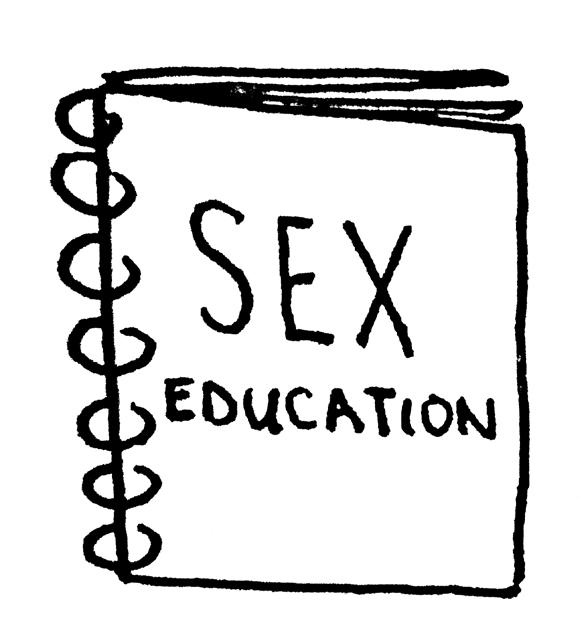
8 minute read
RETHINKING SEX EDUCATION
by HCAmerican
Wyatt Foster
Doodles by Noël Sedona James
Advertisement
The controversy around how sex education should be taught and who should teach it are not new hot topics. The role of the government, religion, morals, science, and personal beliefs have always played a significant role in shaping who is teaching sex ed and who it is funded by. While in the past sex education was heavily focused on sexually transmitted infections and abstinence before marriage tactics, there have always been voices advocating for change towards creating a more comprehensive sex education framework. Controversy also circled around whether sex education was the responsbility of the State or Federal government in terms of providing information, regulations, and funding. Today, the debate over “abstinence-only” or “comprehensive sex education” rages on, with advocates on both sides. But what these two terms mean can be confusing, and need defining. Furthermore, what the studies are now showing in terms of the most effective ways to prevent the spread of STIs and HIV/AIDS, prevent unintended pregnancies, and promote consensual sex and healthy relationships, as well as the social movements that are prompting shifts in cultural narratives around sexuality, sensuality, and consent are shaping the discussion and the future of sex education.

According to Alexandra Lord’s Condom Nation, Sex education has long been seen as a form of fighting public health epidemics in the United States. In the 1990s, the fight against the HIV/AIDS epidemic was the center of the conversation just as gonorrhea and syphilis were a main concern throughout the earlier 20th century. Many people saw the Federal government as the center for providing information and addressing these public health issues, but there has always been push back against the Federal government’s “encroachment” on what is seen as our most private and personal lives. This controversy has led to public health officials, including Surgeon General Joycelyn Elders in the 1990’s, to lose their jobs, and is a reflection of the ambivalence from Americans towards sex education and the role of the Federal government’s reach. Since the 1960’s the importance of sex education in schools gained widespread support. However, since the 1980s, there has been conflict over with path to take: comprehensive sex education or abstinence-only education. Those in support of comprehensive sex education felt that providing accurate and comprehensive information about sexual health and well being would decrease risk-taking behavior among young people. In contrast, those in support of abstinence only sex education believed that medically accurate and comprehensive information would increase risk-taking behavior among young people.
So what does sex education look like today? According to Planned Parenthood, 93% of parents support teaching sex ed in middle school and 96% support teaching sex ed in high school. Many also support sex ed that covers a wide range of topics including STIs, puberty, healthy relationships, sexual orientation, and contraception. Furthermore, sex education is supported by many prestigious health and medical organizations including the American Medical Association, the American Academy of Pediatrics, and the Society for Adolescent Health and Medicine, and over 150 organizations are members of the National Coalition to Support Comprehensive Sexuality Education. But determining what sex education currently looks like in the United States is not an easy task, as curriculums vary widely depending on state regulations and much of the actual teaching practices are left up to individual school districts. Currently, only 24 states and D.C. mandate sex education, and 34 mandate HIV education. For more specific state by state information, visit the Guttmacher Institution’s report on Sex and HIV education. There are a few more things, however, that we do know. The first is that according to the 2014 CDC School Health Profiles, fewer than half of high schools and only one fifth of middle schools teach all of the 16 topics that the CDC deems as essential components of sex education. These include topics ranging from basic information on HIV and STI transmission and how to prevent infection, to critical communication and decision-making skills. Sadly, the Guttmacher Institute reported that fewer teens now than in the past are receiving important and timely information about sex education topics. In 2011 to 2013, 43% of adolescent females and 57% of adolescent males didn’t receive information about birth control before the first time they had sex. And while there was a decrease in formal education, there was no increase in the proportion of teens discussing these topics with their parents. But from what the current studies are showing us, it seems that while the debate rages on, comprehensive sex education is the most effective at reducing the rates of sexual activity, sexual risk behavior, unintended pregancies, and STI tranmission. But what exactly does comprehensive sex education entail and what are the goals of future sex education programming?


The Future of Sex Education, a collaboration of Advocates for Youth, Answer, and SIECUS, have joined together in the effort to create a national dialogue about the necessity of sex education for youth. In order to promote institutionalized and comprehensive sex education programming in public schools, they have created the National Sex Education Standards with the goal “to provide clear, consistent, and straightforward guidance on the essential, minimum, core content and skills needed for sex education that is age-appropriate for students in grades K–12 to be effective”. The aim of this guide is nine fold. To outline the minimum, essential, core content and skills for sex education for K-12. To provide guidance for schools when designing sex education programming. To provide clear rational for teaching sex education content that is evidenceinformed, age-appropriate, and theory-driven. To support schools in improving academic performance. To present sexual development as a normal, natural, healthy part of human development. To offer clear recommendations for school personnel on what is age-appropriate to teach each grade. To translate an emerging body of research related to schoolbased education so that it can be used in the classroom. To address the ever-evolving learning needs of students. And, lastly, to ground the educational experience in social justice and equity, that values the diversity of students (racial, ethnic, gender, orientation, ability, socio-economic, as well as academic) and promotes awareness, understanding, and appreciation of diversity and inclusion. The NSES also includes the guiding principals that sex education should have high expectations for education, use functional knowledge and skills, be traumainformed, promote social, racial, and reproductive justice equity, be intersectional, and include language inclusivity such as gender identities, sexual orientations, and sexual identities. Overall, comprehensive sex education is aimed at being inclusive to all sexual identities, be intersectional, be research-based, be medically accurate, address individual values, attitudes, beliefs and group norms that support healthy behavior, promote consent education and self responsibility, provide age-appropriate education and information, engage with multiple learning strategies, and building personal and group competence to increase healthy behavior and harm reduction.

Perhaps the three newest focuses in contemporary comprehensive sex education strategies are the significant emphases on consent, inclusivity, and intersectionality. Sex education has a long history of racial injustice including issues such as the Tuskegee Study and the promotion of the false narrative that Black people were inherently hypersexual beings who were, paradoxically, also infantalized through the idea that they were mentally incapable of maturing beyond puberty. This has caused many Black communities to be left out of the conversation around sex education. Through the lens of intersectionality and the emphasis put on racial inclusion, the hope for the future of sex education is that it will not only address the issues of the past, but include every identity in the creation of a better future of sex education. Furthermore, the inclusion of all sexual orientations and identities as well as a less abilist-minded approach to sex education will, hopefully, allow for sex ed to promote acceptance and to normalize all forms of sexuality that have for a long time been considered to be “immoral” or “wrong”. Lastly, in the wake of the #MeToo movement, there is a new push for consent training to begin in school with children as young as 1st graders. Consent can be taught in the context of both inside and outside of the bedroom, and therefore can be made age appropriate so that young people can start having these discussions of consent, boundary setting, and communication at a young age. This comes at a very important time, as the CDC estimates that 1 in 4 girls and 1 in 6 boys are sexually abused or assaulted by the age of 18, and this doesn’t even account for transgender and non-binary folks who are often times at an even higher risk of assault. Furthermore, in a survey of over 3000 high school students and young adults nationwide, the vast majority had never been taught how to avoid sexually harassing others. Teaching consent as a life skill and not just a sex skill starting at a young age may change the mindset of a whole generation of young people. This could potentially create a more empathetic, caring, and respectful society, which is intolerant of sexual assault, harassement, and rape culture.
It’s certainly true that the debate over abstinence-only versus comprehensive sex eduation programming will inevitably continue. But with the emerging prominence of movements that value social justice and the evidence pointing towards the necessity of comprehensive sex educaiton programming, it seems that we are slowly taking steps in the right direction towards young people receiving the education they not only need, but deserve.












